When I first thought about what color to paint the front door, I figured it’d be a quick decision. But standing in the paint aisle, staring at the multiple shades of a color such as red, I realized it was anything but simple.
If you’ve been wondering how to pick a front door color or searching for the best front door colors, this guide will save you time and stress.
I’ll walk you through what really matters: your home’s style, the weather where you live, HOA rules, and how long certain finishes last.
Additionally, I’ve included color suggestions, hardware tips, and testing advice to help you feel confident before opening that paint can. Keep reading and you’ll find what you need to make the right choice.
What to Know Before Picking a Front Door Color?
Your front door is one of the first things people notice when they approach your home, making color selection more important than it seems.
Learning how to pick a front door color means understanding what influences this choice, helping you select a shade that looks inviting, feels intentional, and works with your entire exterior.
The right color can affect your property’s value since buyers often connect a fresh, attractive entry with a cared-for home. Color also carries meaning; reds feel energetic, blues feel calming, and black suggests strength.
Knowing how color impacts perception and curb appeal gives you a solid foundation for making a confident decision that reflects both style and purpose.
How to Choose What Color to Paint the Front Door?
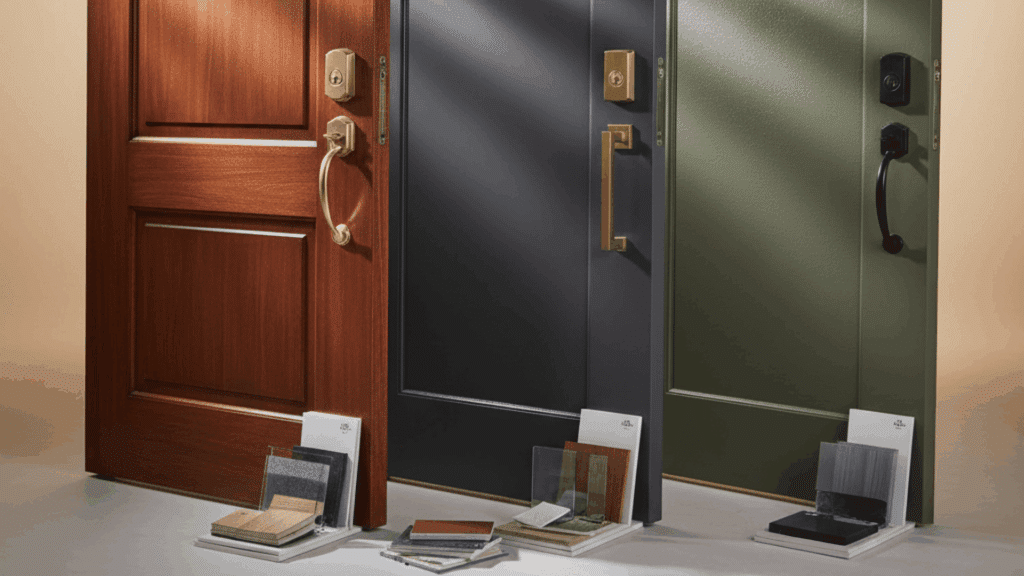
Choosing a front door color goes beyond picking a pretty shade. It requires balancing your home’s architecture, existing colors, personal style, and practical considerations to create an entrance that feels intentional and inviting.
1. Start with Your Exterior Palette
Look closely at your siding, trim, roof, brick, stonework, and landscaping. These elements form a canvas where your door color must cooperate, not compete.
A light house often benefits from a darker door for contrast, while dark exteriors can be brightened with lighter shades. Consider whether you want your door to blend seamlessly into the design or create an intentional focal point that draws the eye.
2. Match Your Home’s Architecture
Every home style has colors that naturally work best. Deep, traditional shades like navy or burgundy flatter colonial and classic houses, while modern designs handle bright colors such as yellow or teal.
Farmhouse styles suit muted greens or black doors. Study similar homes in your area for inspiration, ensuring your front door looks deliberate rather than like an afterthought.
3. Use a Color Wheel for Guidance
A color wheel helps you confidently choose complementary or contrasting shades instead of guessing. If your siding is blue, an orange-toned door offers bold contrast.
Beige homes often pair well with soft greens for a calming effect. This simple tool helps you avoid clashing undertones and ensures the shade you pick enhances your entire exterior instead of fighting with it.
4. Factor in Personal Style and Neighborhood Context
Your front door reflects your personality before guests even step inside. Bright colors signal confidence and energy, while muted neutrals create a calm, timeless appearance.
However, check your HOA rules and surrounding homes before deciding. Some communities require neutral shades for uniformity, while others allow bolder colors.
Matching or gently contrasting with nearby houses helps your entry feel intentional and accepted while preventing conflicts with regulations.
5. Consider Material, Finish, and Lighting
Door material affects how paint looks and lasts. Wood, metal, fiberglass, and doors with glass inserts respond differently to color and finish.
Gloss and semi-gloss paints highlight details and resist moisture, while matte hides flaws but needs more care.
Outdoor light dramatically changes appearance: test colors under morning, midday, and evening conditions to see their true effect.
6. Test Samples Before Committing
Never skip painting test swatches on the actual door. Check them in sunlight, shade, and under porch lights to see real-life variations. Compare how each shade interacts with trim, siding, and landscaping.
While evaluating, think about your desired mood and maintenance willingness. This final step lets you commit with confidence, knowing the color works with your style and upkeep needs.
Paint Finish and Long-Term Durability
The type of finish you choose for your front door is just as important as the color itself. Gloss and semi-gloss paints are popular because they resist moisture, stand up to frequent cleaning, and make details pop.
These finishes also tend to last longer, though they will show surface flaws more easily. Matte or satin finishes, on the other hand, help hide imperfections and create a softer look but are less durable against weather and wear.
Durability also depends on your climate; sunlight fades bright shades more quickly, while damp conditions may cause peeling or cracking.
Choosing the right finish means fewer touch-ups, better long-term value, and a door that continues to look fresh year after year.
Climate Impact on Front Door Color and Durability
Your location determines how well door colors withstand weather extremes. Choose colors and finishes that match regional challenges to reduce fading, peeling, and frequent maintenance.
| Climate Type | Key Challenges | Best Colors & Why | Ideal Finish | Paint Formula & Maintenance |
|---|---|---|---|---|
| Sunny/Hot | UV fading, heat absorption, and cracking | Light tones (white, cream, pale gray) reflect heat and resist fading better | Semi-gloss or high-gloss | UV-resistant formula; inspect annually; repaint every 5–7 years |
| Coastal/Humid | Salt corrosion, moisture damage, mildew, peeling | Light to medium shades hide salt residue; avoid matte finishes | Gloss or semi-gloss | Marine-grade or 100% acrylic latex; clean quarterly; touch up every 1–2 years |
| Cold/Wet | Freeze-thaw cracking, moisture seepage | Medium shades; avoid very dark colors that stress materials | Semi-gloss or satin | Elastomeric or high-flexibility paint; inspect post-winter; seal cracks promptly |
Lighter colors with glossier finishes last longest in extreme climates. Use climate-specific formulas and adjust maintenance frequency based on local weather severity.
Best Front Door Colors & Their Effect
Choosing the right front door color affects attractiveness, mood, and value. These expert-approved shades show how color transforms your entry’s look.
1. Red: Inviting, Bold Statement
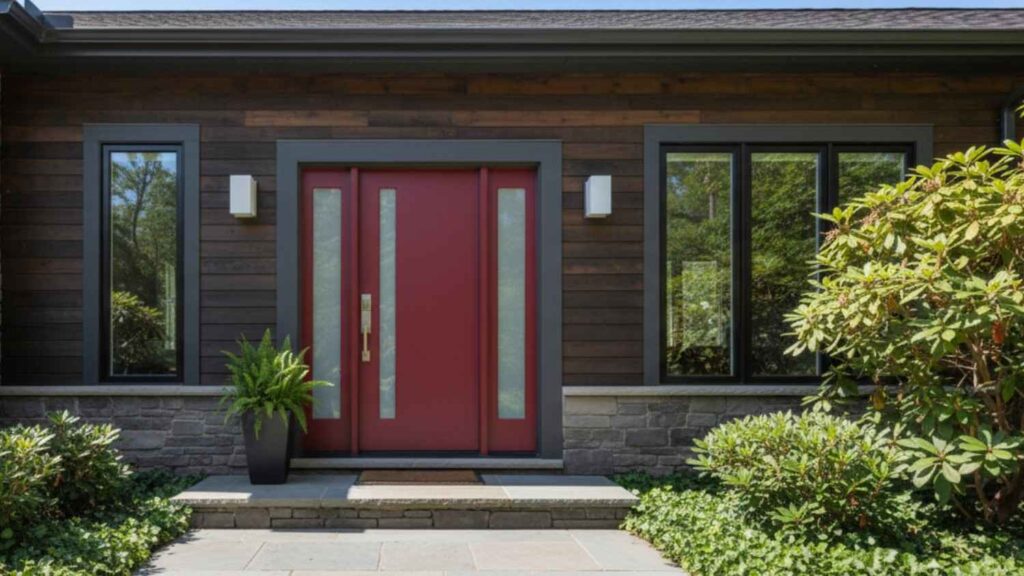
Red doors instantly stand out and create a warm, welcoming feel for visitors. They work especially well with neutral siding or brick, giving your entry personality without looking overdone.
This shade reflects energy, confidence, and tradition, making it a favorite for homeowners who want a classic yet lively touch.
Recommended shades:Behr Prairie Rose M170-2, Benjamin Moore Heritage Red HC-181.
2. Blue: Calm, Classic, Versatile
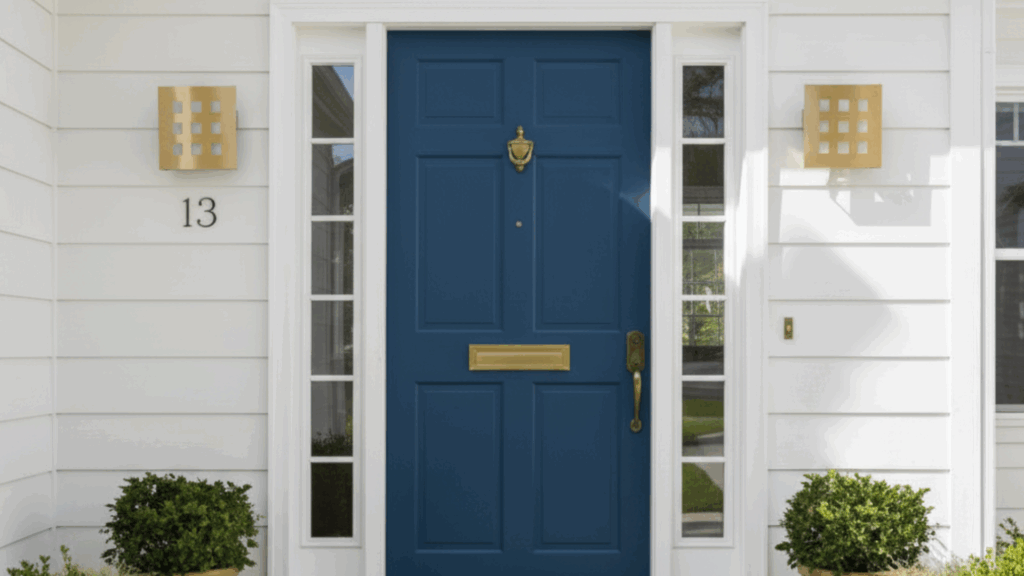
Blue brings a balanced, relaxed tone to your entry. Deep navy shades give a stately feel, while softer tones suggest coastal calmness.
Blue works across many house styles, from modern to traditional, and pairs well with white trim, stone, or lighter siding. It’s ideal when you want dependable color with broad appeal and long-term style.
Recommended shades:Sherwin-Williams Naval SW 6244, Behr Compass Blue MQ5-54.
3. Black: Classic High Contrast
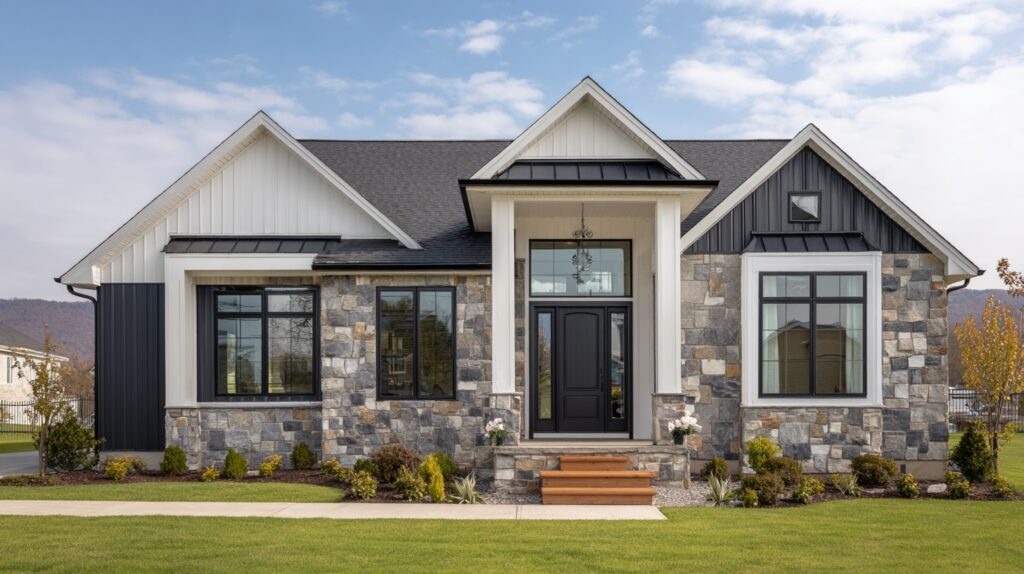
Black doors add drama and finesse to almost any exterior. They create a strong contrast with light siding and highlight hardware beautifully. Black also signals strength and formality, making your home look cared for and intentional.
It’s a great option when you want a bold yet enduring statement that won’t feel trendy in a few years.
Recommended shades:Sherwin-Williams Tricorn Black SW 6258, Behr Black HDC-MD-04.
4. Green: Natural, Welcoming
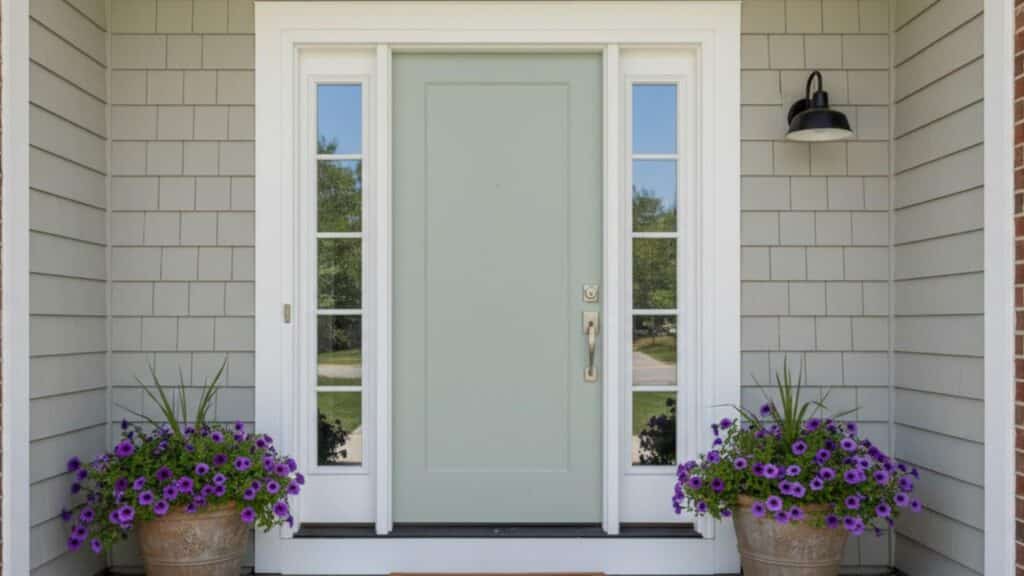
Green doors blend your home with its surroundings and work beautifully with landscaping. Soft greens feel calm and balanced, while deeper greens add grounded character to neutral or earthy exteriors.
Green is especially appealing for farmhouse or cottage-style homes and complements brick, stone, and wood effortlessly. It’s a natural pick when you want a welcoming but distinctive entry.
Recommended shades:Sherwin-Williams Retreat SW 6207, Behr Breezeway MQ3-21.
5. Orange: Cheerful & Eye-Catching
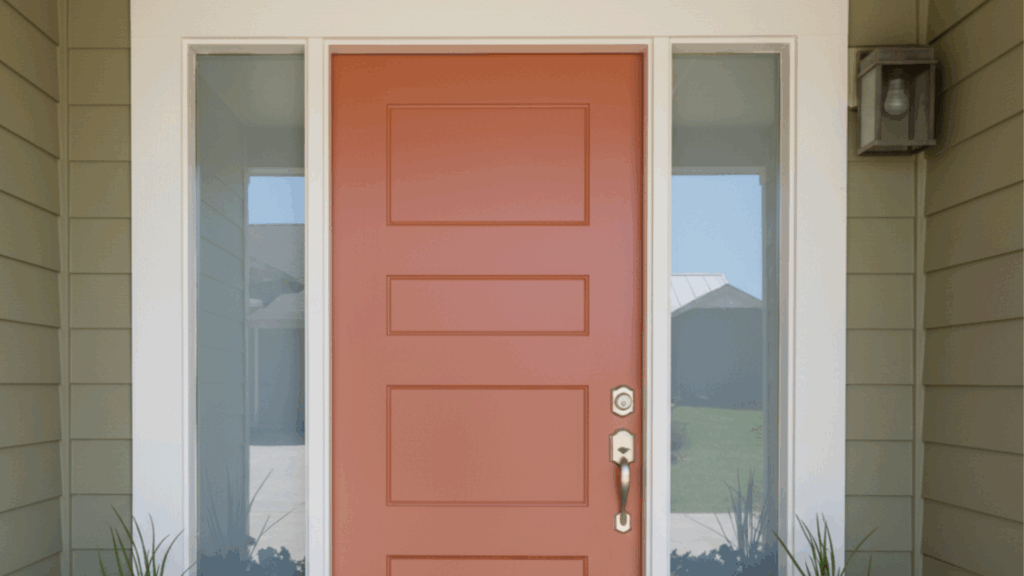
Yellow and orange doors create instant energy and optimism at your entry. These bright hues catch attention and make even small porches feel lively.
They work best as a contrast on neutral or dark exteriors, giving personality without overwhelming the facade. For a softer twist, use an orange with earthy undertones or a muted sunny yellow.
Recommended shades:Sherwin-Williams Coral Clay SW 9005, Behr Pure Turquoise M460-4 (blue-green energy).
6. Gray & Neutral Tones: Subtle & Flexible
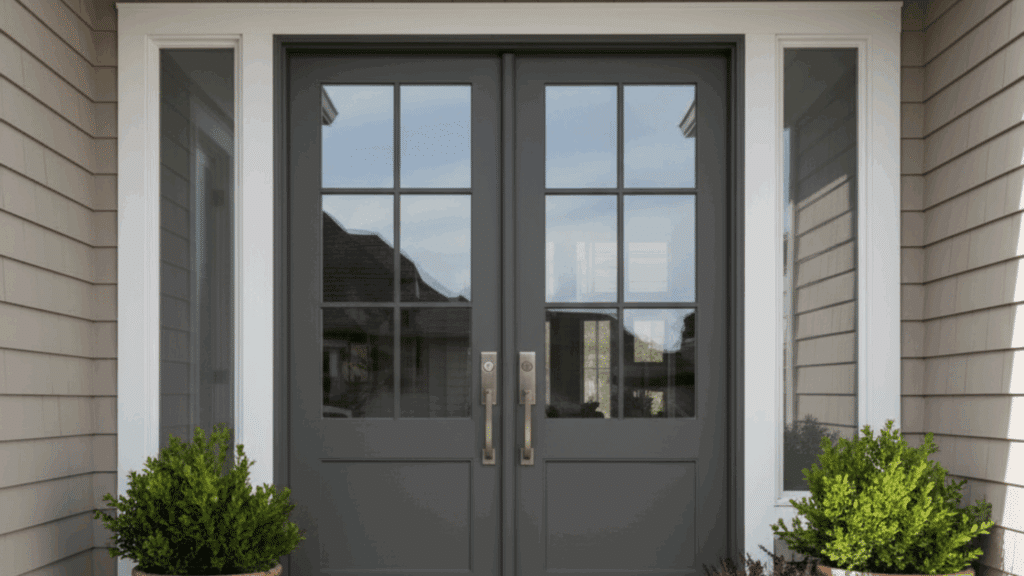
Gray and other neutral tones are understated yet powerful for creating balance. They pair with virtually any siding color, hardware finish, or landscaping style.
Medium to dark grays add structure and depth, while lighter neutrals keep things soft and airy. These colors are ideal for long-lasting allure with minimal upkeep and wide buyer appeal.
Recommended shades:Benjamin Moore Kendall Charcoal HC-166, Sherwin-Williams Urbane Bronze SW 7048.
7. White: Clean & Simple
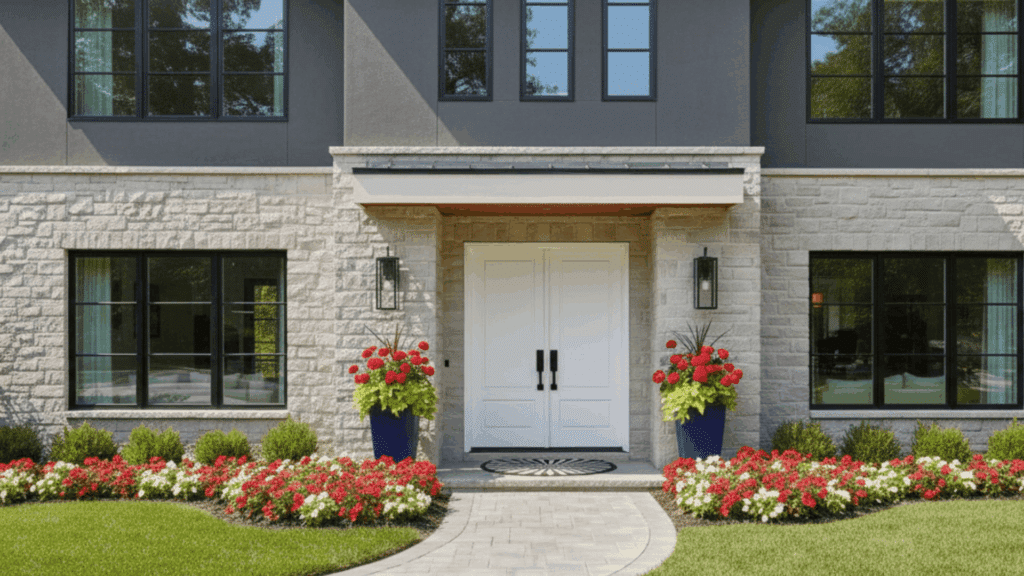
White doors serve as a blank canvas for bold accents, such as black hardware, colorful planters, or patterned welcome mats. They keep an entry looking fresh and open while complementing any exterior palette.
White works especially well with traditional homes but also brightens modern or dark facades. It’s a safe choice if you prefer timeless simplicity and easy updates over time.
Recommended shade:Benjamin Moore Simply White OC-117
Tip: Always test a large swatch before committing. Light, trim color, and surroundings change how a shade appears outside.
Coordinating Hardware and Accessories
Your front door’s color and hardware should work together to create a cohesive, finished look. Use these tips:
- Match or contrast key pieces: Handles, knobs, knockers, mail slots, and hinges can either blend with your door color or stand out for effect. Matching makes the entry seamless, while contrast draws attention to the hardware as a design feature.
- Select the right finish: Brushed nickel, matte black, brass, bronze, or chrome. Each creates a distinct mood. Warmer metals feel traditional; cooler tones look modern. Choose a finish that complements your exterior palette and door color.
- Plan surrounding accents: Coordinate planters, porch lighting, welcome mats, and house numbers so they echo your hardware finish and color scheme. This frames your entry beautifully.
This step ensures your entire entrance feels intentional, polished, and welcoming, making your front door look like part of a planned design.
Budget and Maintenance Considerations
Choosing a front door color also involves weighing the cost, paint quality, and long-term maintenance. Use the table below to guide your decision:
| Aspect | Budget Paint | Premium Paint | Impact |
|---|---|---|---|
| Cost per Gallon | $30–$75 | $75–$150+ | Premium costs 2–3x more upfront |
| Lifespan | 2–3 years | 5–7+ years | Premium lasts 2–3x longer |
| Repainting Frequency | Every 2–4 years | Every 5–8 years | Fewer repaints = lower long-term costs |
| Touch-Ups Needed | Annually | Every 2–3 years | The budget requires more maintenance |
| Climate Resistance | Degrades faster | Better UV/moisture protection | Critical in harsh climates |
| 5-Year Total Cost | $150–$300 | $200–$350 | Premium, often cheaper long-term |
Bottom Line: Premium paints cost more initially but typically save money over time through better durability and fewer repaints. Budget paints work best for short-term stays or mild climates.
How to Keep Your Front Door Color Looking Fresh?
Proper maintenance extends the life of your front door paint and keeps it looking vibrant for years without frequent repainting.
- Use durable, climate-appropriate paint and reapply a protective topcoat every few years to maintain weather resistance.
- Clean the door regularly with mild soap and water to prevent dirt buildup, fading, and grime.
- Inspect edges and corners for chips or cracks, then handle small touch-ups immediately before damage spreads.
- Avoid harsh chemicals or abrasive cleaners that can strip paint and damage the finish.
- Check weatherstripping and seals annually to prevent moisture intrusion that causes paint peeling.
Following these simple steps protects your investment and keeps your entrance looking polished with minimal effort.
Conclusion
Choosing the right front door color shapes first impressions, highlights your home’s character, and even reduces long-term upkeep.
When I updated my own door, the change felt small but made the entire exterior look fresh and complete. Take your time testing samples, trust the process, and use the steps and color recommendations here as your roadmap.
Your front door is more than an entrance; it’s the first statement your home makes.
What color are you leaning toward, or have you already painted yours? Share your experience in the comments below!














